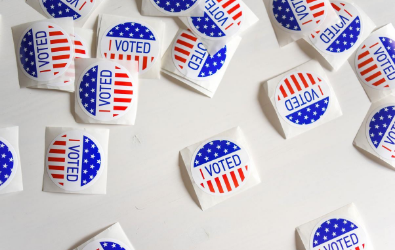Due to social distancing guidelines, both the Democrat and Republican parties faced the challenge of holding virtual conventions, during which speakers faced cameras instead of thousands of cheering delegates, all in one big powerful room filled with natural and vibrant human energy. The result of the modified conventions is expected to impact this election and future conventions. It is no wonder that President Trump enlisted two former producers of his show The Apprentice to plan the Republican convention.
Despite the lost human connection, there were still many lessons learned about ways in which we can all create better visual and social media campaigns for our own causes. Here are some of the strategies to emulate:
Seek out meaningful locations.
While a book filled study is a popular location for virtual appearances, the Democratic convention benefited from some of the out of the box locations where speeches were made, from former Ohio Governor John Kasich’s appearance at a literal crossroad to the gorgeous virtual tour of the United States that turned the usually dull ritual of the roll call of the states into something memorable. The Republicans followed suit, showing a video on the first night of President Trump speaking to first responders in the White House to remind people of his powerful position and create a patriotic feel. Each place was thoughtfully chosen to create enthusiasm among party supporters, with an eye to increasing turnout at the polls come November. Picking a background that speaks to who you are and what you do gives your words additional impact.
Include relatable voices.
While speeches by the candidates and other political dignitaries give conventions gravitas, the appearances by regular people can be just as, if not more, effective because audiences, which are made up of regular people, can connect with them on emotional and personal levels. The brave speech of 13-year-old Bryaden Harrington of NH about how Joe Biden helped him with his stuttering gave voice to 3 million people facing similar challenges and highlighted the Democratic presidential candidate’s empathy better than his words ever could. The first night of the Republican convention featured grieving father Andrew Pollack, who lost his daughter in the Parkland school shooting. He believes students and teachers will be safer with President Trump in office.
Have a social media plan.
Social media platforms are a major source of news for Americans. According to a Pew Research Center 2018 survey, over two-thirds of Americans reported getting at least some of their news from social media — including 43% from Facebook, 21% from YouTube, and 12% from Twitter. The elements of both conventions were designed to be seen and shared on Facebook and other social media platforms. Convention planners from both parties were prepared with visuals and assets to encourage supporters to get involved and show off their convention spirit. Digital toolkits gave party members the means to showcase their support for their respective the presidential candidates. In addition, each party created “tune in live on social media” and “b-roll ready” landing pages on their websites to inform viewers of who to expect in the convention line up and included individual tags/mentions and hashtags (#DemConvention and #GOPConvention.


Photos by Democratic Convention and Republication Convention
Create shareable social media moments that target demographic groups.
Both conventions were designed to build moments that are easy to consume in real-time on social media and create personal connections by targeting specific demographic groups. At the Democratic convention, programming mixed live speeches and prerecorded set pieces, including a Zoom-style singing of the national anthem and musical performances from Billie Eilish and other artists meant to appeal to a younger demographic. Black former NFL star Herschel Walker spoke about his 37 year friendship with President Trump in an effort to give the GOP a more diverse image.
COVID-19 has pulled the convention into a new era. The digital transformation of virtual events, conventions, and campaigns are likely to continue because they better fit the way Americans now consume and share information online. While nothing can replace the power of human connection, the way in which the conventions made the best of our current situation highlighted the importance of, and gave example for, how to connect content with intended audiences.


